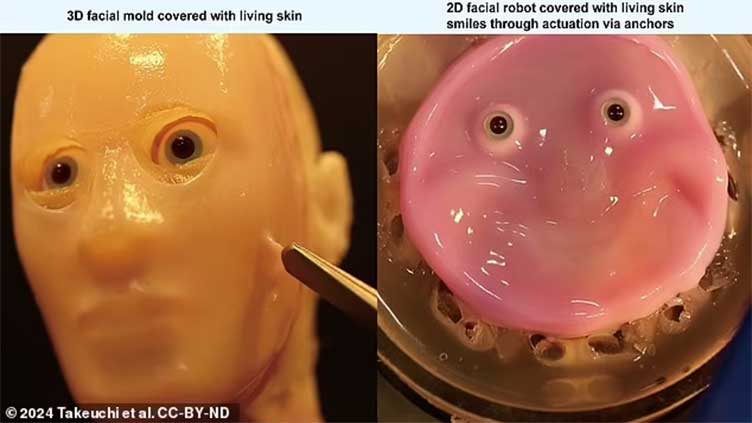Humanoid robot with face made out of living skin tissue created

Technology
Robots could heal themselves if damaged
(Web Desk) - Scientists in Japan have created a robotic face out of lab-grown human skin.
Creepy video shows the bizarre pink creation attempting a cheesy smile.
According to the scientists, robots with real skin not only have an 'increasingly lifelike appearance' but could heal themselves if damaged.
The research has been led by Professor Shoji Takeuchi of the University of Tokyo and detailed in a new study in Cell Reports Physical Science.
Professor Takeuchi's lab has already created mini robots that walk using biological muscle tissue, 3D printed lab-grown meat and engineered skin that can heal.
'We managed to replicate human appearance to some extent by creating a face with the same surface material and structure as humans,' said Professor Takeuchi.
The 'engineered skin tissue' is made by taking a sample of human skin cells and growing them in the lab – similar to how cultured meat is developed.
Study co-author Michio Kawai at Harvard University told MailOnline: 'These human skin cells are mainly harvested from excess skin obtained during surgeries.
'Cultured skin has the same composition as human skin and is also used as a graft material for people with severe burns or injuries.'
While engineering living skin from cell cultures has its own challenges, the trickiest bit was getting the skin to attach to a robotic face, made of acrylic-based resin.
Previous methods involved mini anchors or hooks, but these limited the kinds of surfaces that could receive skin coatings and could cause damage during motion.
So instead, the team used a special collagen gel for adhesion and made special perforations in their robot face, helping the layer of lab-grown skin take hold.
By carefully engineering small perforations, essentially any shape of surface can have skin applied to it, they say.
Although there's a long way to go until talking humanoids that look just like us, Professor Takeuchi and colleagues believe living skin can bring a range of new abilities to robots.
Robots with skin on their face boast self-healing abilities, embedded sensing capabilities and an 'increasingly lifelike appearance'.
'This research introduces an approach to adhere and actuate skin equivalents with perforation-type anchors, potentially contributing to advancements in biohybrid robotics,' they say in their paper.
'Unlike other self-healing materials, which require heat or pressure to trigger adhesion at cut surfaces, skin equivalent can regenerate defects through cellular proliferation without any triggers.'
The next challenge will be is creating a range of humanlike expressions by integrating sophisticated actuators, akin to muscles, inside the robot.


